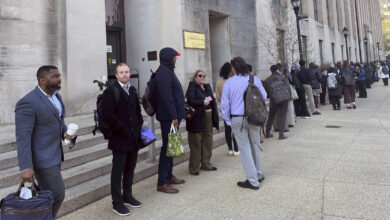Biden-Harris Administration Invests in Clean Energy and Fertilizer Production to Strengthen American Farms and Businesses as Part of Investing in America Agenda
Projects Funded by President Biden’s Inflation Reduction Act Will Lower Energy Costs and Create Revenue for Rural Business Owners and Farms
OMAHA, Neb., March 28, 2024 – U.S. Department of Agriculture (USDA) Secretary Tom Vilsack today announced that USDA is investing $124 million in renewable energy and fertilizer production projects in 44 states to lower energy costs, generate new income and create jobs for U.S. farmers, ranchers, agricultural producers and rural small businesses.
The Secretary made the announcement during a visit to University of Nebraska Omaha, where he discussed USDA’s efforts under the Biden-Harris Administration to invest in rural communities nationwide. Most of the projects announced today are being funded by President Biden’s Inflation Reduction Act, the nation’s largest-ever investment in combating the climate crisis, through the Rural Energy for America Program. An additional project is funded by the Fertilizer Production Expansion Program. In total, this funding advances the President’s Investing in America agenda to grow the nation’s economy from the middle out and bottom up by increasing competition in agricultural markets, lowering costs and expanding clean energy.
“Under the Biden-Harris Administration, USDA is committed to ensuring farmers, ranchers and small businesses are directly benefitting from both a clean energy economy and a strong U.S. supply chain,” Secretary Vilsack said. “The investments announced today will expand access to renewable energy systems and domestic fertilizer, all while creating good-paying jobs and saving people money that they can then invest back into their businesses and communities.”
This visit comes just weeks after USDA selected Midwest Electric Cooperative, located in Grant, NE, and the Village of Emerson, NE as two of its first applicants to move forward in the awards process through the Powering Affordable Clean Energy program. Midwest Electric Cooperative will build solar renewable energy resource facilities and energy storage systems for the communities in Wallace, Grant, Paxton and Lakeview. The Village of Emerson plans to use the funds to finance a solar facility that will distribute clean energy to the Winnebago Tribe.
Rural Clean Energy Production
Today’s announcement includes an investment of over $120 million in 541 Rural Energy for America Program (REAP) projects across 44 states.
Through the REAP program, USDA provides grants and loans to help ag producers and rural small business owners expand their use of wind, solar and other forms of clean energy and make energy efficiency improvements. These innovations help them increase their income, grow their businesses, address climate change and lower energy costs.
The REAP program is part of the President’s Justice40 Initiative, which set a goal to deliver 40% of the overall benefits of certain federal investments to disadvantaged communities that are marginalized by underinvestment and overburdened by pollution.
These investments will cut energy costs for farmers and ag producers that can instead be used to create jobs and new revenue streams for people in their communities. For example:
- In Nebraska, Darr Grain will install three 15-kilowatt (kW) wind turbines at a grain storage facility. This project is expected to save the business $9,700 in electrical costs per year and generate more than 138,000 kilowatt hours (kWh) of electricity per year. This represents 77% of the company’s energy use, which is enough to power nine homes.
- In Maine, Moorit Hill Farm will install a 40.95 kW roof mount solar system. The system will save the farm more than 50,000 kWh per year, which is equivalent to approximately 100% of the farm’s energy use. This is enough clean energy to power nearly five homes, replace 50,000 pounds of burning coal, or replace approximately eight gasoline powered cars.
- In Idaho, Boulder Creek Oz will purchase and install a biomass furnace to provide additional heat to their cabins and mountain lodging facilities in Boundary County. This project is expected to save more than $3,800 per year. It will replace more than 3,700 kWh, which is approximately 94% of the energy use per year.
USDA is making the REAP awards in Alabama, Alaska, Arkansas, California, Colorado, Connecticut, Delaware, Florida, Georgia, Hawaii, Idaho, Illinois, Indiana, Iowa, Kansas, Kentucky, Louisiana, Maine, Maryland, Massachusetts, Michigan, Minnesota, Mississippi, Missouri, Montana, Nebraska, New Hampshire, New Jersey, New Mexico, North Carolina, North Dakota, Ohio, Oklahoma, Pennsylvania, Rhode Island, South Carolina, South Dakota, Tennessee, Utah, Vermont, Virginia, Washington, Wisconsin and Wyoming.
Since the start of the Biden-Harris Administration, USDA has invested more than $1.8 billion through REAP in over 6,000 renewable energy and energy efficiency improvements that will help rural business owners’ lower energy costs, generate new income, and strengthen their resiliency of operations.
USDA continues to accept REAP applications and will hold funding competitions quarterly through September 30, 2024. The funding includes a dedicated portion for underutilized renewable energy technologies. For additional information on application deadlines and submission details, see page 19239 of the March 31 Federal Register.
Domestic Fertilizer Production
Since the start of the Biden-Harris Administration, USDA has invested more than $174 million through the Fertilizer Production Expansion Program (FPEP) to support 42 projects nationwide to boost domestic fertilizer production.
Today, USDA is providing nearly $4 million in FPEP funding to Bluestem Systems to build facilities and purchase equipment at three locations in Iowa and Nebraska. The facilities will help the company make advancements in its innovative process to remove water and pathogens to create a dry fertilizer mix. The project is expected to yield 3,800 tons of dry fertilizer per year and 11,400 tons annually across all three facilities, which will be made available to 1,500 producers.
Through FPEP, USDA provides grants to independent farmers and agricultural business owners to help them produce fertilizer. Funds can be used to modernize equipment, adopt new technologies, build fertilizer production plants and more. This program helps boost domestic fertilizer production while lowering costs and creating new income streams for U.S. farmers.
USDA Rural Development provides loans and grants to help expand economic opportunities, create jobs and improve the quality of life for millions of Americans in rural areas. This assistance supports infrastructure improvements; business development; housing; community facilities such as schools, public safety and health care; and high-speed internet access in rural, tribal and high-poverty areas. Visit the Rural Data Gateway to learn how and where these investments are impacting rural America. To subscribe to USDA Rural Development updates, visit the GovDelivery Subscriber Page.
USDA touches the lives of all Americans each day in so many positive ways. Under the Biden-Harris Administration, USDA is transforming America’s food system with a greater focus on more resilient local and regional food production, fairer markets for all producers, ensuring access to safe, healthy and nutritious food in all communities, building new markets and streams of income for farmers and producers using climate-smart food and forestry practices, making historic investments in infrastructure and clean energy capabilities in rural America, and committing to equity across the Department by removing systemic barriers and building a workforce more representative of America. To learn more, visit www.usda.gov.
#
USDA is an equal opportunity provider, employer, and lender.



